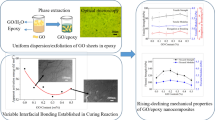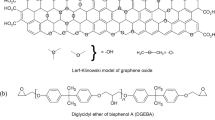Abstract
The influence of graphene nanoplatelets (GNPs) on the curing of an epoxy resin based on diglycidyl ether of bisphenol A (DGEBA) and cross-linked with 4,4′-diaminodiphenylmethane (DDM) was studied. Dynamic mechanical properties and tensile properties of the corresponding graphene/epoxy nanocomposites were obtained. Two compositions 1 and 5 mass% of GNPs were studied. The cross-linking reaction of the epoxy resin is accelerated in dispersions with 5 mass% GNPs. In the presence of GNPs, the curing reaction becomes less exothermic, obtaining less perfect epoxy networks compared to neat epoxy (DGEBA–DDM) thermoset. Accordingly, the glass transition temperatures (T g) of the nanocomposites are lower than that of the neat epoxy thermoset. This effect is not detected for low content of graphene (1 mass%). Protocol of curing having two isothermal steps leads to more perfect networks than the dynamic curing in the DSC. The T g reduction is minimized in the samples cured through two isothermal steps. The storage moduli of the nanocomposite containing 5 mass% graphene, both in the glassy (T < T g) and the rubbery (T > T g) states, are higher than the ones of neat epoxy thermoset, being most pronounced this effect at T > T g. Tensile tests confirmed the higher elastic moduli of the nanocomposites; however, a decrease in strain at break and tensile strength was observed for the nanocomposite containing 5 mass% of GNPs. This brittle behavior is consistent with the morphology of the samples studied by scanning electron microscopy.






Similar content being viewed by others
References
Hu K, Kulkarni D, Choi I, Tsukruk V. Graphene-polymer nanocomposites for structural and functional applications. Prog Polym Sci. 2014;39:1878–907.
Kuilla T, Bhadra S, Yao D, Kim NH, Bose S, Lee JH. Recent advances in graphene based polymer composites. Prog Polym Sci. 2010;35:1350–75.
Prolongo SG, Jiménez-Suárez A, Moriche R, Ureña A. In situ processing of epoxy composites reinforced with graphene nanoplatelets. Compos Sci Technol. 2013;86:185–91.
Prolongo SG, Jiménez-Suárez A, Moriche R, Ureña A. Graphene nanoplatelets thickness and lateral size influence on the morphology and behavior of epoxy composites. Eur Polym J. 2014;53:292–301.
Monti M, Rallini M, Puglia D, Peponi L, Torre L, Kenny JM. Morphology and electrical properties of graphene–epoxy nanocomposites obtained by different solvent assisted processing methods. Compos A. 2013;46:166–72.
Díez-Pascual AM, Naffakh M, Marco C, Ellis G, Gómez-Fatou MA. High-performance nanocomposites based on polyetherketones. Prog Mater Sci. 2012;57:1106–90.
Gude MR, Prolongo SG, Ureña A. Effect of the epoxy/amine stoichiometry on the properties of carbon nanotube/epoxy composites. J Therm Anal Calorim. 2012;108:717–23.
Shiravand F, Hutchinson JM, Calventus Y. Influence of the isothermal cure temperature on the nanostructure and thermal properties of an epoxy layer silicate nanocomposite. Polym Eng Sci. 2014;54:51–8.
Cowie JMG, Arrighi V. Polymers: chemistry and physics of modern materials. London: Taylor & Francis Group; 2008.
Puglia D, Valentini L, Armentano I, Kenny JM. Effects of single-walled carbon nanotube incorporation on the cure reaction of epoxy resin and its detection by Raman spectroscopy. Diam Relat Mater. 2003;12:827–32.
Puglia D, Valentini L, Kenny JM. Analysis of the cure reaction of carbon nanotubes/epoxy resin composites through thermal analysis and Raman spectroscopy. J Appl Polym Sci. 2003;88:452–8.
Fu Y, Zhong W. Cure kinetics behavior of a functionalized graphitic nanofiber modified epoxy resin. Thermochim Acta. 2011;516:58–63.
Prolongo SG, Moriche R, Jiménez-Suárez A, Sánchez M, Ureña A. Advantages and disadvantages of the addition of graphene nanoplatelets to epoxy resins. Eur Polym J. 2014;61:206–14.
Ozawa K. Estimating isothermal life from thermogravimetric data. Bull Chem Soc Jpn. 1966;38:1881–4.
Costa ML, Pardini LC, Rezende MC. Influence of aromatic amine hardeners in the cure kinetics of an epoxy resin used in advanced composites. Mater Res. 2005;8:65–70.
Zvetkov VL, Calado V. Comparative DSC kinetics of the reaction of DGEBA with aromatic diamines III. Formal kinetic study of the reaction of DGEBA with diamino diphenyl methane. Thermochim Acta. 2013;560:95–103.
Miranda MIG, Tomedi C, Bica CID, Samios D. A DSC kinetic study on the effect of filler concentration on crosslinking of dyglycidylether of bisphenol-A with 4,4-diaminodiphenylmethane. Polymer. 1997;38:1017–20.
Vyazovkin S, Sbirrazzuoli N. Isoconversional kinetic analysis of thermally stimulated processes in polymers. Macromol Rapid Commun. 2006;27:1515–32.
Riande E, Díaz-Calleja R, Prolongo MG, Masegosa RM, Salom C. Polymer viscoelasticity: stress and strain in practice. New York: Marcel Dekker; 2000.
Sánchez-Cabezudo M, Masegosa RM, Salom C, Prolongo MG. Correlations between the morphology and thermo-mechanical properties of poly(vinyl acetate)/epoxy thermoset blends. J Therm Anal Calorim. 2010;102:1025–33.
Tang LC, Wang YJ, Yang D, Pei YB, Zhao L, Li YB, Wu LB, Jiang JX, Lai GQ. The effect of graphene dispersions on the mechanical properties of graphene/epoxy composites. Carbon. 2013;60:16–27.
Chatterjee S, Wang JW, Kuo WS, Tai NH, Salzmann C, Li WL, Hollertz R, Nüesch FA, Chu BTT. Mechanical reinforcement and thermal conductivity in expanded graphene nanoplatelets reinforced epoxy composites. Chem Phys Lett. 2012;531:6–10.
Wang X, Jin J, Song M. An investigation of the mechanism of graphene toughening epoxy. Carbon. 2013;65:324–33.
Acknowledgements
The authors acknowledge the financial support from the Ministerio de Economía y Competitividad of Spain. Project MAT2013-46695-C3.
Author information
Authors and Affiliations
Corresponding author
Rights and permissions
About this article
Cite this article
Prolongo, M.G., Salom, C., Arribas, C. et al. Influence of graphene nanoplatelets on curing and mechanical properties of graphene/epoxy nanocomposites. J Therm Anal Calorim 125, 629–636 (2016). https://doi.org/10.1007/s10973-015-5162-3
Received:
Accepted:
Published:
Issue Date:
DOI: https://doi.org/10.1007/s10973-015-5162-3




